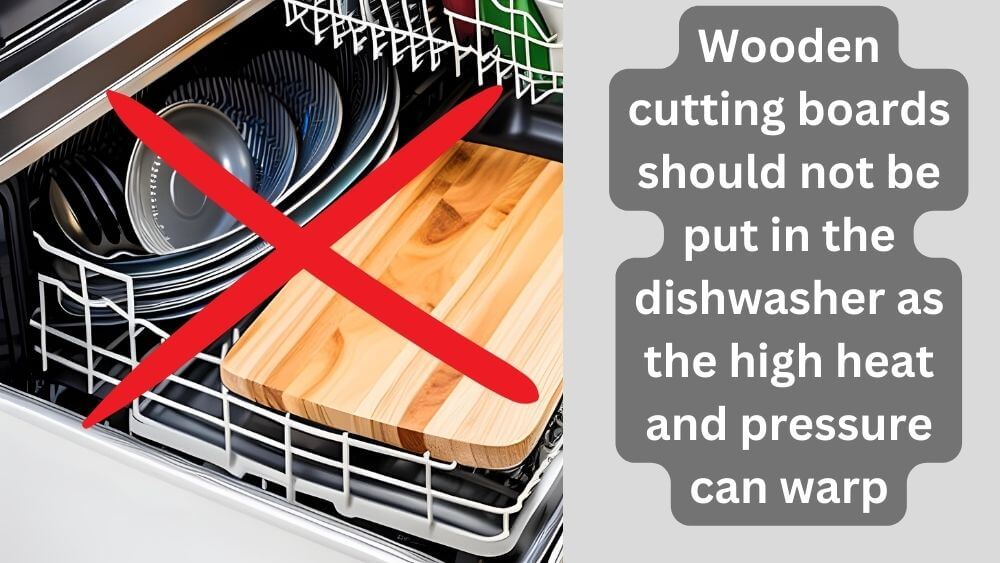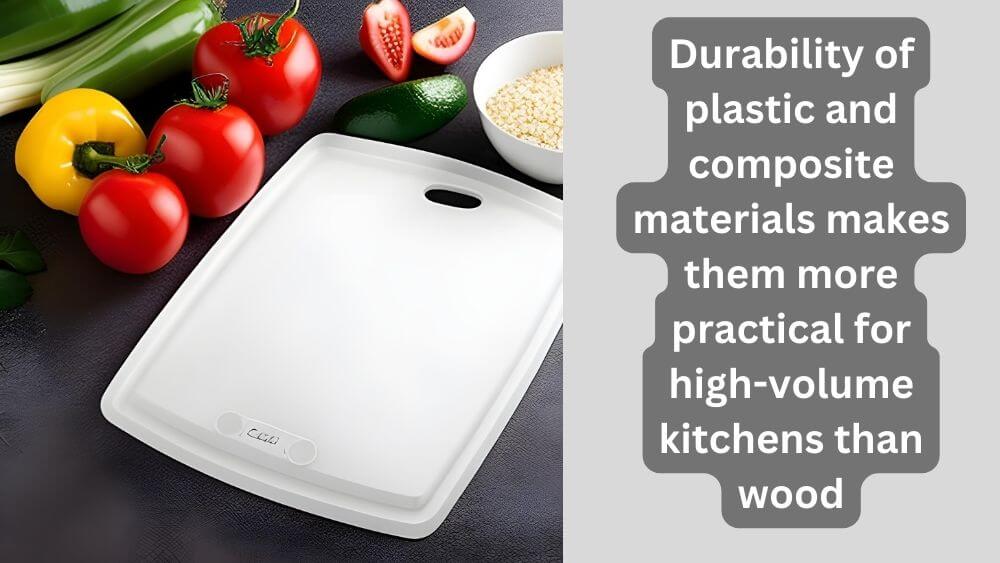
As a chef, I have always been interested in the tools we use in the kitchen, significantly cutting boards. Wooden cutting boards have long been a staple in many home kitchens, but professional restaurant kitchens use them much less frequently. If you peek into most restaurant kitchens, you’ll likely see plastic or synthetic cutting boards being used. It made me wonder why restaurants don’t use wooden cutting boards and whether they might be missing out on some of the benefits of wood.
A wooden cutting board has many advantages in the home kitchen, such as durability, resistance to knife marks, and attractive appearance. But restaurants are a little different because they often have different needs and considerations regarding food safety and sanitation, so they favor plastic or synthetic cutting boards.
I decided to write this article to give a clear answer to the question of Why restaurants do not use wooden cutting boards? There are many reasons for this, and I want to ensure the explanation is easy to understand. Chefs know a lot about materials and tools used in kitchens, and I want to share my thoughts with everyone interested.
Sanitation
Wooden cutting boards are not the best choice for keeping things clean in a restaurant kitchen. This is because they easily absorb juices from cut foods such as meat juices, chicken marinara, fish liquid, and the like that would not be imaginably healthy if absorbed inside the structure of a wooden cutting board. And can trap germs and bacteria inside the board. This can make it difficult to clean the board correctly and increases the risk of food poisoning.
Not only that, but wooden cutting boards can also be easily scratched and damaged by knives, making them more challenging to clean properly. This damage can create small gaps where germs and bacteria can hide and grow.
Many restaurants prefer cutting boards made from plastic or other synthetic materials to keep things clean and safe in the kitchen. This type of cutting board is easy to clean and less likely to harbor harmful bacteria.
Maintenance
Maintenance is an important consideration when using wooden cutting boards in restaurants. Unlike plastic or synthetic boards, wooden cutting boards require regular oiling and seasoning to prevent them from drying out and cracking. This can take a lot of time and effort, especially in a busy restaurant where chefs are working under pressure to prepare food quickly.
A poorly maintained wooden cutting board can become a breeding ground for bacteria and other contaminants. Wooden cutting boards can develop deep knife marks and grooves over time, harrowing harmful bacteria and making them more difficult to clean thoroughly. Because of the challenges and costs associated with maintaining wooden cutting boards, restaurants opt for plastic or synthetic cutting boards instead. This type of cutting board is less expensive, easier to clean, and does not require regular maintenance.
Cannot be cleaned in a dishwasher
Another problem is that wooden cutting boards cannot be put in the dishwasher. Wooden cutting boards should not be put in the dishwasher as the high heat and pressure can warp, crack or even break them. This means they must be washed by hand, which can be time-consuming and requires special attention to ensure they are adequately cleaned and sanitized. In a busy restaurant setting, where time is a precious resource, the inability to use a dishwasher for cleaning can be a significant inconvenience. As a result, many restaurants choose plastic or synthetic cutting boards that can be easily cleaned and sanitized in a dishwasher, saving time and labor.
Sands and oils occasionally
They need occasional oiling and sanding to keep wooden cutting boards in good condition. This helps prevent the wood from drying out, which can lead to cracks and splits, making the board unusable. Lubrication also helps protect the board from moisture and bacteria. Sanding helps remove rough spots or blemishes that have accumulated over time. And this process is time-consuming and requires some effort, which is why restaurants prefer to use plastic or synthetic cutting boards that are low maintenance and easy to clean.
Cost
Cost is another reason why wooden cutting boards are rarely found in commercial kitchens. Cost concerns restaurants and wooden cutting boards are usually more costly than plastic or synthetic ones. As a chef, the cost of wooden cutting boards may be a concern when considering purchasing cutting boards for the restaurant. They are often more expensive than plastic or synthetic options, which could make it challenging to invest in them, particularly if trying to save money. Wooden cutting boards might be a good investment for a home kitchen, where they can last for many years with proper care, but in a restaurant where they are used heavily, they might need to be replaced more frequently, adding to the cost. Because of this, many restaurants choose plastic or synthetic cutting boards over wooden ones.
Durability
Durability is also a reason why restaurants don’t use wooden cutting boards. Although wooden cutting boards are popular, they may not be as durable as their plastic or synthetic counterparts. Over time, wooden boards can develop deep knife marks and cracks, becoming a breeding ground for harmful bacteria. This makes cleaning and maintenance complex, creating a potential food safety risk. In contrast, plastic and synthetic cutting boards are generally more durable and can withstand repeated use and frequent cleaning without showing as much wear and tear. This makes it a more practical choice for busy restaurant kitchens where hygiene and efficiency are essential.
Difficult to clean
Another reason wooden cutting boards are not popular in commercial restaurants is that they can be challenging to clean and require a lot of care. In a restaurant setting, proper cleaning and sanitation are crucial to ensure food is safe for customers. Wooden cutting boards can absorb moisture and harbor bacteria, making it difficult to thoroughly clean and sanitize them. This can increase the risk of cross-contamination and compromise the food’s safety. To prevent this problem, restaurants often choose materials like plastic or synthetic boards that are easier to clean.
Separation
Separation is essential in restaurant kitchens to prevent cross-contamination and ensure food safety. Different cutting boards are used for meats, poultry, fish, vegetables, and cooked foods; keeping them separate is crucial. Wooden cutting boards don’t offer the option of color-coding, which makes it difficult to distinguish between them and increases the risk of cross-contamination. For this reason, restaurants choose plastic or synthetic cutting boards that can be easily color-coded for different types of food.
Because of this problem, we don’t use wooden cutting boards in restaurants. Many reasons explain why restaurants prefer other materials instead of wood, especially plastic cutting boards in commercial kitchens and restaurants.
The things you shouldn’t cut on wooden boards
Wooden cutting boards are versatile and durable but have limitations when preparing food. Some foods should not be cut on a wooden board because they can damage the board or pose a risk of contamination. Here are some things to avoid cutting on your wooden cutting board:
Cutting acidic foods on wooden boards is not recommended. These foods can penetrate the board’s surface and cause it to become discolored, stained, or even brittle. Second, it is best not to cut raw meat, poultry, or seafood on a wooden board. Raw meat can contain harmful bacteria that penetrate the board’s surface, making it difficult to sterilize. This can increase the risk of cross-contamination, primarily if you use the same board to cut vegetables or fruits. To reduce the risk of contamination, it is recommended to use a dedicated cutting board for meat and another for fruit and vegetables.

Advantages and Disadvantages of wooden cutting boards
Wooden cutting boards have been a kitchen staple for centuries. They are favored by many home cooks and professional chefs alike for their durability, aesthetic appeal, and natural properties. However, wooden cutting boards also have their fair share of disadvantages.
| Advantages of Wooden Cutting Boards | Disadvantages of Wooden Cutting Boards |
| Natural and renewable material | More porous than other materials, which can make them harder to clean and more prone to bacterial growth |
| Kind to knives, helping to maintain their sharpness | Can absorb moisture, which can cause warping and splitting over time |
| Attractive and aesthetically pleasing | Require more maintenance and care compared to other materials |
| Less likely to dull or damage knives compared to hard materials like glass or metal | Can be more expensive than other materials like plastic or bamboo |
| Provide a traditional and rustic feel, which can enhance the dining experience | Can be more difficult to sanitize properly, making them less suitable for high-volume, fast-paced restaurant environments |
| Offer a non-slip surface that can help prevent accidents in the kitchen | May not meet certain health and safety regulations in certain regions or jurisdictions |
| Can be customized and personalized for a unique touch | Can be heavier and more cumbersome to use compared to other materials like plastic or silicone |
Advantages and Disadvantages of plastic cutting boards
Plastic cutting boards have become a popular alternative to wooden ones due to their affordability, lightweight, and easy cleaning. One significant advantage of plastic cutting boards is their resistance to bacteria and cross-contamination, making them a safer choice for cutting meat and poultry. However, plastic cutting boards have some disadvantages, such as being prone to scratches and cuts, which can harbor bacteria and make them more challenging to clean.
| Advantages of Plastic Cutting Boards | Disadvantages of Plastic Cutting Boards |
| Non-porous surface that is easy to clean and sanitize | Can become scratched and nicked over time, providing areas for bacteria to grow |
| Affordable and widely available | Can dull knives more quickly than other materials like wood or bamboo |
| Lightweight and easy to handle | Can warp or melt if exposed to high temperatures or direct heat |
| Resistant to staining and odor absorption | May not be as aesthetically pleasing as other materials like wood or stone |
| Can be color-coded for specific types of food, helping to prevent cross-contamination | May not provide the same non-slip surface as other materials like rubber or silicone |
| Durable and long-lasting | May be less eco-friendly compared to other materials like bamboo or wood |
| Can be easily replaced if damaged or worn | Can be less satisfying to use compared to more traditional materials like wood or stone |
Are wooden or plastic chopping boards better
While wooden chopping boards are beneficial, restaurants typically do not use them. The primary reason is that wood is a porous material that can harbor bacteria and other microorganisms. Over time, deep cuts and grooves can develop in the wood, making it difficult to thoroughly clean and sanitize. Leaving bacteria on the board and transferring them to food poses a potential health risk.
Restaurants are held to strict health and safety standards, so they often opt for non-porous materials like plastic or composite materials. These materials are easier to clean and sanitize, which helps to reduce the risk of cross-contamination and the spread of foodborne illness. The durability of plastic and composite materials makes them more practical for high-volume kitchens than wood.
While wooden chopping boards may be more aesthetically pleasing, they are not always the best restaurant choice. The health and safety of customers are the top priority, and using non-porous materials like plastic or composite materials can help to ensure that food is prepared safely and without the risk of contamination.

Faqs
What types of cutting boards are typically used in restaurants?
Plastic, composite, and rubber cutting boards are typically used in restaurants due to their durability, ease of cleaning, and non-porous surfaces.
What materials are commonly used for cutting boards in restaurants?
Commonly used materials for restaurant cutting boards include plastic, composite materials, and rubber. Some restaurants also use bamboo and other types of wood, but these require more frequent maintenance and sanitation to ensure food safety.
Are there any benefits to using wooden cutting boards in restaurants?
Wooden cutting boards are often praised for their aesthetic appeal and natural beauty. Additionally, some chefs prefer the feel of a wooden cutting board and find that it’s easier on their knives. Despite these benefits, many restaurants are concerned about bacterial contamination and the extra maintenance required.
Can bamboo cutting boards replace wooden cutting boards in restaurants?
Bamboo cutting boards are a durable and sustainable alternative to wooden ones and can be used in restaurants. However, they also require regular maintenance to prevent warping and cracking.
Why is it essential to sanitize cutting boards?
Sanitizing cutting boards is essential to minimize the risk of contamination and keep food safe.
Conclusion
According to experience, there are several reasons why restaurants don’t use wooden cutting boards. Wooden cutting boards can be challenging to clean and sanitize, are less durable than other materials, and can pose potential health risks. Plastic cutting boards are a more practical and hygienic choice for restaurants, as they are non-porous, durable, and easy to clean and maintain. While wooden cutting boards may be aesthetically pleasing, they are not the best choice for commercial kitchens where hygiene and food safety are paramount. By using plastic cutting boards, you can ensure that your customers are served safe, high-quality food.

As the chief content writer, Hassan Al Sarker works as a professional kitchen-based content creator at Kitchen Liker.
In addition to reviewing the content published on Kitchen Liker, he ensures that it is accurate, relevant, and helpful. As a result, all the reviews and information published at Kitchen Liker are neutral and userfriendly.
Hassan Al Sarker has a bachelor’s degree in Hotel and Tourism Management From the Newyork University. Before joining Kitchen Liker, he was a contributor at Kitchen Club, United States.
